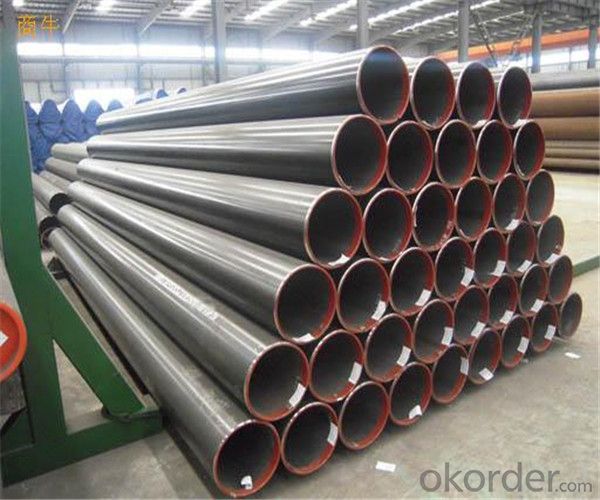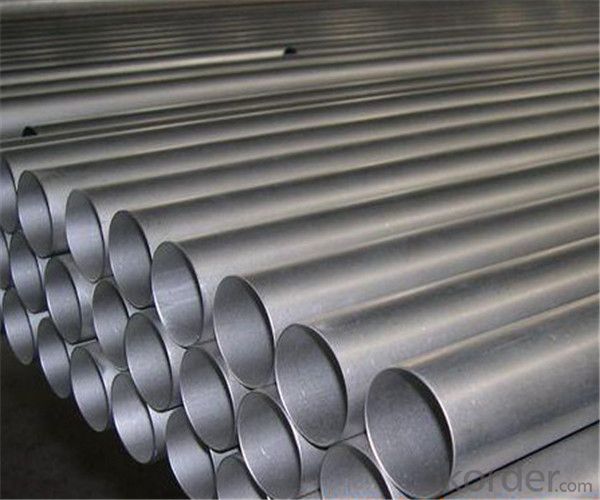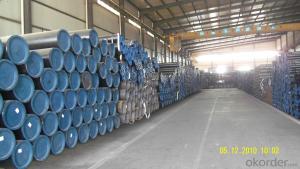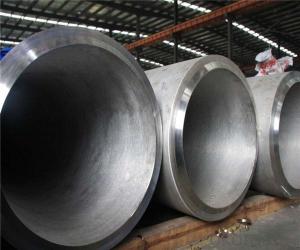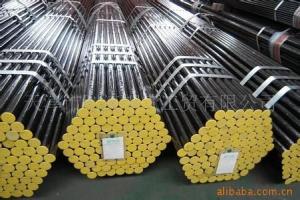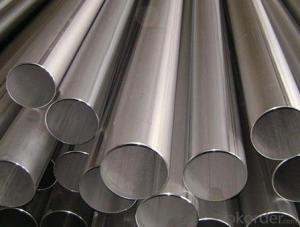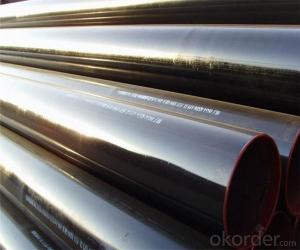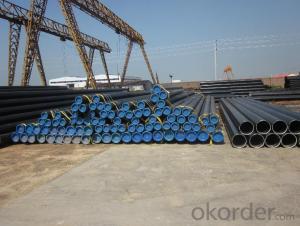2016 API Pipe seamless steel pipe with good quality from CNBM International Group
- Loading Port:
- Tianjin
- Payment Terms:
- TT or LC
- Min Order Qty:
- 100 m.t.
- Supply Capability:
- 3000000 m.t./month
OKorder Service Pledge
OKorder Financial Service
You Might Also Like
PRODUCT DETAILS
1.Structure of Seamless Steel Pipe Description:
A large amount of Seamless Steel Pipes is offered to the clients at cost effective rates. These pipes are extremely durable, resistant to corrosion and have high tensile strength. Our pipes are used in nuclear plants, power plants, refineries and construction industry across the country. Furthermore, we are capable of providing these seamless pipes to the clients in bulk quantity.
2.Main Features of the Steel Pipe:
• High manufacturing accuracy
• High strength
• Small inertia resistance
• Strong heat dissipation ability
• Good visual effect
•Reasonable price
3.Packaging & Delivery:
| Packaging Details: | Seaworthy packages, bundles wrapped with strong steel strip |
| Delivery Detail: | 15-30 days after received 30% TT |
4.Seamless Steel Pipe Specification:
| Standard: | GB, DIN, ASTM,ASME, ASTM A106-2006, ASTM A53-2007 |
| Grade: | 10#,20#, 45#, 16Mn |
Thickness: | 8 - 33 mm |
| Section Shape: | Round |
| Outer Diameter: | 133 - 219 mm |
| Place of Origin: | Shandong, China (Mainland) |
| Secondary Or Not: | Non-secondary |
| Application: | Hydraulic Pipe |
| Technique: | Cold Drawn |
| Certification: | API |
| Surface Treatment: | factory state or painted black |
| Special Pipe: | API Pipe |
| Alloy Or Not: | Non-alloy |
| Length: | 5-12M |
| Outer Diameter: | 21.3-610mm |
5.Product pictures
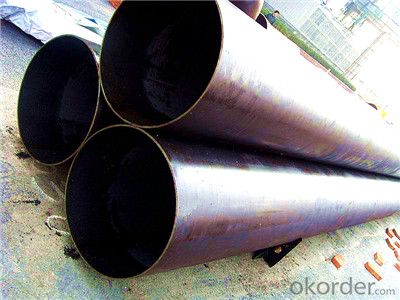
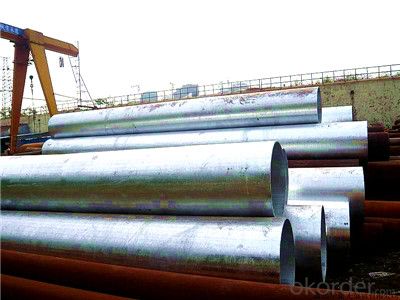

5.FAQ of Seamless steel pipe:
①How is the quality of your products?
Our products are manufactured strictly according to national and internaional standard, and we take a test
on every pipe before delivered out. If you want see our quality certifications and all kinds of testing report, please just ask us for it.
Guaranteed: If products’ quality don’t accord to discription as we give or the promise before you place order, we promise 100% refund.
②How about price?
Yes, we are factory and be able to give you lowest price below market one, and we have a policy that “ for saving time and absolutely honest business attitude, we quote as lowest as possible for any customer, and discount can be given according to quantity”,if you like bargain and factory price is not low enough as you think, just don’t waste your time.Please trust the quotation we would give you, it is professional one.
③Why should you chose us?
Chose happens because of quality, then price, We can give you both.Additionally, we can also offer professional products inquiry, products knowledge train(for agents), smooth goods delivery, exellent customer solution proposals.Our service formula: good quality+good price+good service=customer’s trust.
SGS test is available, customer inspection before shipping is welcome, third party inspection is no problem.
Any question, pls feel free to contact us !
- Q: What are the different types of supports used for steel pipes in buildings?
- Steel pipes in buildings commonly utilize various types of supports. These supports serve different purposes and are typically made of metal or plastic materials. Firstly, pipe hangers are designed to bear the weight of the pipe. They are securely attached to the building structure and prevent the pipe from sagging or shifting. Pipe clamps, on the other hand, are employed to fasten the pipe to a wall or other structural element. These clamps consist of a metal band that encircles the pipe and is then fixed to the structure using bolts or screws. Their main function is to provide stability and prevent any movement or vibration of the pipe. For distributing the weight evenly and offering additional support, pipe shoes are installed beneath the pipe. These support devices are typically made of metal or rubber and can be attached to the building structure or embedded in concrete foundations. To guide the movement of the pipe and prevent excessive bending or shifting, pipe guides are utilized. These guides, usually composed of metal or plastic, are installed at regular intervals along the length of the pipe. Lastly, pipe rollers are employed to support horizontal pipes and permit expansion and contraction due to temperature changes. Made of metal, these rollers allow the pipe to move freely without causing any harm to the building structure. It is crucial to select the appropriate type of support based on the specific requirements of the steel pipe and the building structure. By properly supporting steel pipes in buildings, their stability, durability, and overall safety are ensured.
- Q: What are the different methods of repairing steel pipes?
- There are several methods to repair steel pipes, including welding, flange coupling, sleeve coupling, epoxy coating, and pipe lining.
- Q: How do you calculate the pipe friction loss for steel pipes?
- The pipe friction loss for steel pipes can be calculated using the Darcy-Weisbach equation, which takes into account the pipe diameter, length, roughness, flow rate, and fluid properties. This equation considers the pressure drop caused by friction as the fluid flows through the pipe. By solving this equation, the pipe friction loss can be determined.
- Q: What are the different types of steel pipe joints for underwater applications?
- Some different types of steel pipe joints for underwater applications include flanged joints, welded joints, and mechanical joints. Flanged joints involve connecting pipes by bolting together flanges at the ends. Welded joints are created by fusing the ends of pipes together using heat and pressure. Mechanical joints use couplings or connectors to join pipes together, typically with rubber seals to ensure a watertight connection.
- Q: How are steel pipes handled and transported safely?
- Steel pipes are handled and transported safely through a combination of proper lifting and handling techniques, secure packaging, and appropriate transportation equipment. Before transportation, pipes are bundled, strapped, or put into crates to prevent any movement or damage during transit. Special lifting equipment such as cranes or forklifts are used to handle them, ensuring that proper weight distribution and balance are maintained. Additionally, securing the pipes to flatbed trucks or using specialized pipe carriers prevents them from rolling or shifting during transportation. Regular inspections, adherence to safety regulations, and trained personnel play a vital role in ensuring the safe handling and transportation of steel pipes.
- Q: Can steel pipes be used for hydroelectric power plants?
- Yes, steel pipes can be used for hydroelectric power plants. Steel pipes are commonly used to transport water in hydroelectric power plants for various purposes such as intake systems, penstocks, and discharge systems. They offer durability, strength, and resistance to corrosion, making them suitable for the challenging environments found in hydroelectric power generation.
- Q: How are steel pipes classified based on pressure ratings?
- Steel pipes are classified based on pressure ratings by assigning them different schedules, ranging from Schedule 10 to Schedule 160. Each schedule represents a different maximum pressure that the pipe can withstand, with higher schedules indicating higher pressure ratings.
- Q: What are the different surface finishes available for steel pipes?
- There are several different surface finishes available for steel pipes, including mill finish, hot-dip galvanized, black oxide, epoxy coating, and powder coating.
- Q: What are the different types of steel pipe coatings?
- There are several types of steel pipe coatings, including epoxy coatings, polyethylene coatings, polyurethane coatings, and zinc coatings. These coatings help protect the steel pipes from corrosion, increase their lifespan, and improve their performance in various environments.
- Q: How are steel pipes coated for underground applications?
- Steel pipes are typically coated for underground applications using a variety of methods, including but not limited to hot-dip galvanizing, epoxy coating, and polyethylene wrapping. These protective coatings help prevent corrosion, increase the lifespan of the pipes, and ensure their reliability in underground environments.
Send your message to us
2016 API Pipe seamless steel pipe with good quality from CNBM International Group
- Loading Port:
- Tianjin
- Payment Terms:
- TT or LC
- Min Order Qty:
- 100 m.t.
- Supply Capability:
- 3000000 m.t./month
OKorder Service Pledge
OKorder Financial Service
Similar products
Hot products
Hot Searches
Related keywords




